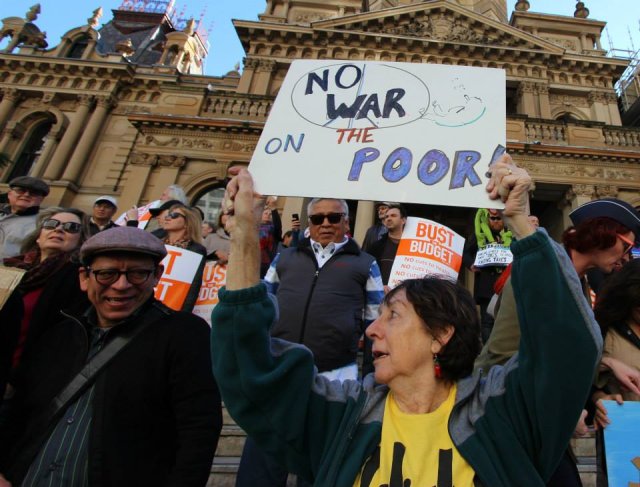
The gains of the first and second waves of the women’s liberation movement were groundbreaking. Yet in Australia today, 14% of women live below the poverty line. Why?
The answer is that since the 1970s, and as part of the overall neoliberal offensive, Labor and Coalition governments have both presided over cuts to funding of women’s services, attacks on child care, education, health, and aged and disability care. New threats are also being posed to women’s reproductive rights.
The wages share of wealth in Australia today has fallen to levels not experienced since the 1960s. An explosion of part-time and casual work has replaced full-time employment. As a result, 40% of Australian workers are in insecure employment today and women are more likely to be working in casual and part-time jobs than men.
Soon after being elected, Tony Abbott’s government moved to block an equal pay win for community services workers, a sector made up of mostly women. The decision by Fair Work Australia to raise the wages of community workers relied on the federal and state governments subsidising the pay rises.
As of November last year, the average wage gap between men and women is 17.1%. But in the community and personal care sector, the gap is up to 28%.
EQUAL PAY
The equal pay decision was a big victory for women. The Abbott government’s determination to deny pay justice to women in this sector was one of the early indications of their budget agenda.
The proportion of women in the paid workforce in Australia today is 65.2%. In the 1960s, it was only 11%. But despite this huge growth, women still face a double burden of paid work in the workforce and unpaid work in the home. Women still carry out 66% of unpaid work in the home, which had an estimated worth in 2009-10 of 50.6% of GDP — six times bigger than the paid care sector.
In 2006, the average amount of time spent by women caring for children aged 0-14 was eight hours and 33 minutes a day, compared with 3 hours and 55 minutes by men.
Accessible child care is still not provided by the state or by employers. Long waiting lists mean delays in women returning to work and rising costs mean that women on low incomes returning to work after having a child spend as much as 72% of their weekly, full-time income on child care.
The National Foundation for Australian Women (NFAW) said that for employed women using family day care, the federal budget means a likely price rise of more than $30 a week per child.
In addition, the freezing of the threshold and indexation for the Child Care Rebate and fee relief will quickly affect all childcare fees, and discourage women from going back to work. The rise in childcare fees for parents on JET (Jobs, Education, Training) Child Care Fee Assistance and a reduction in available hours of JET subsidised care will discourage participation in work and training for low-income women.
The NFAW study also found that an unemployed sole parent (most of whom are women) with one eight-year-old loses $54 a week. A sole parent who earns about two-thirds of the average wage loses between 5.6% and 7% of their disposable income.
The cost of university courses with high female enrolment is likely to rise higher than those with higher male enrolment patterns. Women will also end up paying more in HECS debt due to receiving lower incomes in the workforce, which will extend the amount of time they take to pay off the debt.
Women’s housing security is also likely to be disproportionately affected.
MEDICARE CUTS
The NFAW said the proposed Medicare co-payment means women will pick up more of the cost and stress of managing the health of children and older relatives. The proposed review of Disability Support Pension recipients under 35 will also disproportionately affect women.
It gets worse for women on low incomes. The budget cuts funding to legal aid services, which many women rely on for help to deal with domestic and family violence, for example. When statistics show that at least one woman is murdered every week in Australia due to domestic violence, cutting legal help is a significant attack on women’s right to live free of violence.
It is disturbing that as it cuts funding to legal aid programs, the government can find $20 million to fund free counselling for couples to prevent the “high cost of divorce”. The Abbott government’s drive to keep families together is ideological, but it also suits the interests of Australian capital, because it shifts the cost of raising children, and caring for the sick and elderly, onto individual families.
These policies echo former PM John Howard’s election speech in 1996 when he declared that “stable, united, functioning families represent the most effective welfare system that any nation can ever devise”.
A small layer of women have risen up to become so-called “industry leaders”. But the overwhelming majority of women are bearing the brunt of the huge attacks on the working class as a whole being carried out by governments as part of their neoliberal agenda.
That is why women must be at the forefront of this fight.
Like Green Left Weekly on Facebook and follow us on Twitter.